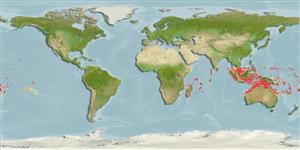Пластиножаберные (акулы и скаты) (sharks and rays) >
Myliobatiformes (Stingrays) >
Dasyatidae (Stingrays) > Urogymninae
Etymology: Pateobatis: Combination of Latin 'pateo' for 'lie open, be exposed' and 'batis' for skate, ray or flatfish; referring to the eclectic nature of members of this group..
More on authors: Jordan & Seale.
Environment: milieu / climate zone / depth range / distribution range
экология
морской ассоциированный с рифами; пределы глубины 0 - 200 m (Ref. 86942). Tropical; 9°N - 26°S
Indo-West Pacific: widespread, from South Africa to the central Pacific Islands, north to Japan (Okinawa). Frequently confused with Himantura jenkinsii (Ref. 9840).
Length at first maturity / Size / Вес / Возраст
Maturity: Lm 115.4, range 120 - ? cm
Max length : 183 cm TL самец/пол неопределен; (Ref. 40637); наибольший вес (опубликованные данные): 18.5 kg (Ref. 40637)
Uniformly tan to brownish pink dorsally. Inhabits lagoon and seaward sand flats from the intertidal to at least 200 m. Occurs in large aggregations (Ref. 37816).
Occurs in aggregations over soft bottoms of the inner continental shelf, often near coral reefs (Ref. 9840). Ovoviviparous (Ref. 50449). Size at birth at about 55 cm WD (Ref. 6871). Feeds on fishes, crustaceans and molluscs (Ref. 89972). Common catch of the demersal tangle net, bottom trawl and, to a lesser extend, longline fisheries. Utilized for its meat, skin (high value) and cartilage (Ref.58048). By-catch of prawn trawlers (Ref. 6871).
Life cycle and mating behavior
половая зрелость | размножение | нерест | икра | Fecundity | личинки
Exhibit ovoviparity (aplacental viviparity), with embryos feeding initially on yolk, then receiving additional nourishment from the mother by indirect absorption of uterine fluid enriched with mucus, fat or protein through specialised structures (Ref. 50449). Distinct pairing with embrace (Ref. 205). Size at birth ~ 55 cm WD (Ref.58048).
Mould, B., 1994. A world list of rays. The scientific nomenclature and distribution of the recent Batoidea (Batoidea, Elasmobranchii, Chondrichthyes). University of Nottingham, [UK]. 82 p. (Ref. 8630)
Статус Красного Списка МСОП (Ref. 130435)
Угроза для людей
Venomous
Использование человеком
рыболовство: не имеет хозяйственного значения
дополнительная информация
ссылкиаквакультура (рыбоводство)особенности рыбоводствастепень растяжениягенетикаElectrophoresesнаследуемостьболезниобработкаNutrientsMass conversion
инструменты
Специальные отчеты
Скачать в формате XML
ресурсы в Интернет
Estimates based on models
Preferred temperature (Ref.
123201): 23.7 - 28.2, mean 26.7 °C (based on 471 cells).
Phylogenetic diversity index (Ref.
82804): PD
50 = 0.5312 [Uniqueness, from 0.5 = low to 2.0 = high].
Bayesian length-weight: a=0.00832 (0.00366 - 0.01891), b=3.10 (2.90 - 3.30), in cm total length, based on LWR estimates for this (Sub)family-body shape (Ref.
93245).
Trophic level (Ref.
69278): 3.7 ±0.57 se; based on food items.
устойчивость к внешним воздействиям (Ref.
120179): низкий, минимальное время удвоения популяции 4.5-14 лет (Assuming fecundity<100).
Fishing Vulnerability (Ref.
59153): Very high vulnerability (90 of 100).
Nutrients (Ref.
124155): Calcium = 4.72 [0.53, 68.64] mg/100g; Iron = 0.359 [0.028, 3.857] mg/100g; Protein = 21.3 [18.7, 23.9] %; Omega3 = 0.0812 [, ] g/100g; Selenium = 45.3 [8.5, 225.5] μg/100g; VitaminA = 19.5 [1.6, 202.1] μg/100g; Zinc = 0.609 [0.036, 7.165] mg/100g (wet weight);
